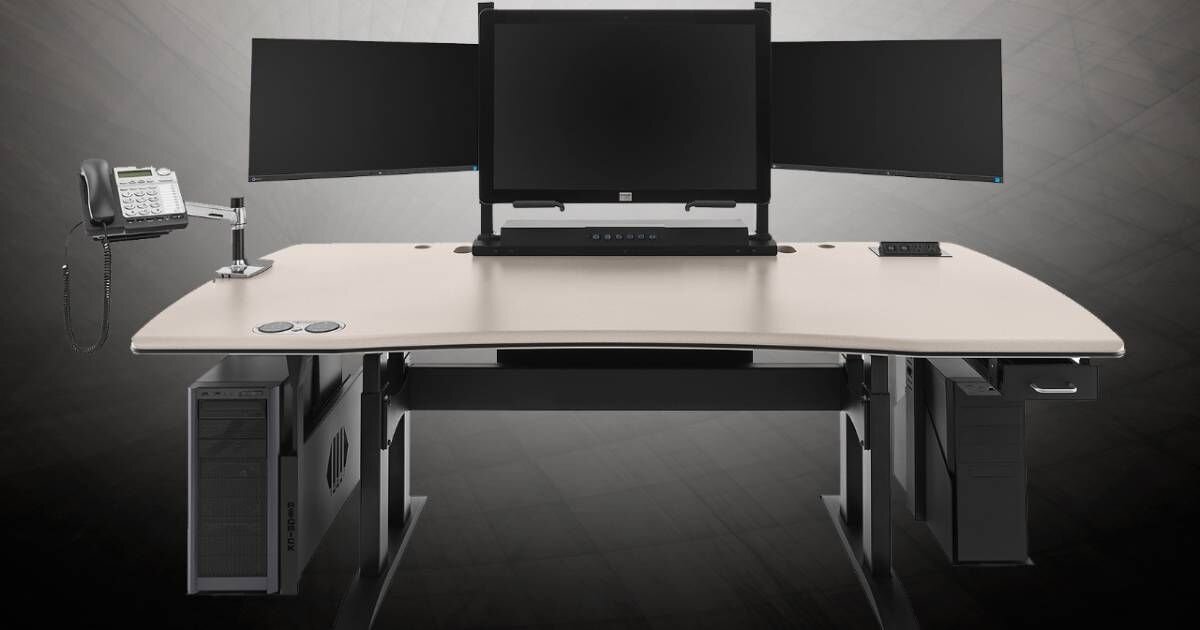
We collect basic website visitor information on this website and store it in cookies. We also utilize Google Analytics to track page view information to assist us in improving our website.

Ergonomics, the science of designing workspaces to fit the people who use them, ensures that workers can perform their tasks comfortably, efficiently, and with minimal risk of injury. But for radiologists, the stakes are especially high. The unique demands of their profession, which involve long hours scrutinizing medical images in dimly lit rooms, can take a significant toll on their bodies.
The physical demands of radiology can lead to musculoskeletal disorders (MSDs), a leading cause of work disability, absenteeism, and lost productivity.
Investing in ergonomic workstations for radiologists is a strategic decision with significant economic benefits. These workstations have the potential to reduce work-related injuries and burnout, providing significant cost savings for healthcare organizations.
Here, we explore a high-level cost benefit analysis, weighing the many costs of poor ergonomics versus the benefits of investing in quality workstations.
At RedRick Technologies, we design and develop ergonomic workspaces for healthcare professionals that include workstations, monitor mounting solutions, accessories, and peripherals. We also provide ergonomic design services that help organizations implement ergonomic principles for improved space design and functionality. Get in touch and let’s find ways to improve the ergonomic functionality of your workspace.
The demanding nature of radiology work takes a significant physical toll on practitioners.
Long hours spent in static postures, repetitive movements like manipulating images, and the strain of peering at monitors in dimly lit rooms can lead to a range of MSDs, including repetitive strain injuries.
Studies indicate that a staggering 30% to 60% of radiologists experience MSD symptoms, which can include chronic back and neck pain, carpal tunnel syndrome, eye strain, and headaches. And nearly 70 million physician office visits in the United States are attributed annually to MSDs—a significant portion of total healthcare encounters.
The impact of these disorders extends beyond physical discomfort; they can significantly impair work performance, leading to decreased productivity, errors, and even absenteeism.
The link between poor ergonomics and MSDs is well-established. Prolonged sitting, repetitive movements, and awkward postures put excessive strain on muscles, tendons, and joints, leading to inflammation, pain, and injury over time. The cumulative effect of these stressors can be debilitating, affecting not only the radiologist's professional life but also their overall quality of life.
MSDs are a leading cause of absenteeism in healthcare. When radiologists are unable to work due to these disorders, it disrupts workflow, reduces productivity, and necessitates hiring temporary replacements, all of which contribute to increased costs.
While exact figures are hard to pinpoint, studies have shown that the financial impact of physician absenteeism, often driven by MSDs, is substantial—and it’s on the rise, with rates climbing each year and reaching 4.66% by 2021.
Absenteeism generates direct costs like lost productivity and the need for temporary staff, as well as indirect costs such as decreased patient satisfaction and potential delays in diagnosis and treatment. These costs can accumulate over time and have a significant impact on a healthcare provider's bottom line.

When radiologists experience chronic pain and exhaustion, it's not uncommon for them to seek positions that offer better working conditions or leave the profession altogether.
Replacing radiologists is a costly endeavor. The costs involved in recruiting, training, and onboarding new radiologists can place a substantial financial burden on healthcare institutions. Additionally, the loss of experienced radiologists can disrupt workflow, decrease productivity, and potentially compromise the quality of care.
While precise figures vary, estimates suggest that the annual cost of physician turnover in the U.S. is around $5 billion. While not all turnover is directly attributable to ergonomics, addressing the physical discomfort and strain that contribute to burnout is an essential step in retaining valuable radiologists and reducing turnover costs.
While research specific to radiology is ongoing, studies in other fields suggest a concerning link between physical discomfort and reduced cognitive function.
Discomfort can impair concentration, increase fatigue, and lead to errors. This possibility is particularly worrisome in the context of radiology, where even small errors in image interpretation can have significant consequences for patient care.
Although more research is needed to quantify the exact impact of ergonomic furniture on diagnostic accuracy in radiology, the potential risks are clear.
Ergonomic workstations are designed to support the natural posture and movements of the human body, addressing the root causes of MSDs.
Adjustable desks allow radiologists to alternate between sitting and standing, reducing the strain of prolonged sitting.
Ergonomic chairs provide proper lumbar support, promoting healthy spine alignment and reducing back pain.
Monitor arms enable optimal screen positioning, minimizing neck and eye strain.
Numerous studies have demonstrated the effectiveness of ergonomic interventions in reducing pain and discomfort among workers in various fields. While research specific to radiology is ongoing, the principles of ergonomics are universal.
Providing radiologists with tools that support their bodies can significantly decrease the risk of MSDs and promote a healthier, more comfortable work environment.
When radiologists are comfortable and free from pain, they can focus better on their work. Ergonomic workstations reduce fatigue and discomfort, allowing radiologists to maintain their concentration for longer periods. This leads to improved work performance, faster image interpretation, and increased overall productivity.
Additionally, ergonomic workstations have the potential to mitigate radiologist burnout. Reducing physical strain and promoting a more comfortable work environment helps radiologists feel more engaged and fulfilled in their work.
The benefits of ergonomic workstations extend beyond the individual radiologist to substantial financial gains for healthcare institutions.
As we've discussed, MSDs are a major cause of absenteeism and turnover in radiology. Healthcare institutions can mitigate these issues and their associated costs by investing in ergonomic solutions. Fewer sick days and reduced turnover translate to less money spent on temporary staffing, recruitment, and training.
While precise calculations will vary depending on the size and specific circumstances of each institution, the potential savings are significant. Consider the estimated annual cost of $5 billion for burnout-related physician turnover in the U.S. Even a small reduction in this figure could result in substantial savings for healthcare providers.
Investing in ergonomic workstations does require an upfront financial commitment. The costs associated with purchasing and installing ergonomic furniture can vary depending on several factors. These include:
Type and quality of equipment (adjustable desks, chairs, monitor arms)
Number of workstations needed
Any additional expenses for professional installation and training.
It's important to acknowledge that this initial investment can be significant but it is also an investment in the health, well-being, and productivity of radiologists. The long-term benefits of this investment far outweigh the initial costs.
By reducing absenteeism and turnover, healthcare institutions can save substantial amounts of money that would otherwise be spent on temporary staffing, recruitment, and training.
Ergonomic workstations can lead to lower healthcare expenses for the institution. By preventing work-related injuries and promoting employee well-being, these workstations can reduce the need for medical interventions, physical therapy, and worker's compensation claims.
Calculating the exact return on investment (ROI) can be complex and will vary depending on various factors. However, studies have shown that ergonomic interventions can lead to significant cost savings. For example, a comprehensive review of over 250 case studies found that ergonomic programs led to an average decrease in absenteeism by 58% and turnover by 48%.
Considering the high prevalence of MSDs and burnout among radiologists, the potential for cost savings through ergonomic workstations is substantial. The initial investment may seem daunting, but the long-term financial benefits, combined with the improvements in employee health, productivity, and job satisfaction, make a compelling case for investing in ergonomic solutions.

The evidence is clear: investing in ergonomic workstations for radiologists is a financially sound decision with numerous benefits. Prioritizing the well-being of your workforce can reduce absenteeism, decrease turnover, and minimize the risk of costly diagnostic errors. Additionally, ergonomic workstations enhance productivity, improve job satisfaction, and contribute to a healthier and more sustainable work environment.
While the initial investment may seem significant, the long-term financial gains, along with the positive impact on employee health and patient care, make ergonomic workstations an invaluable asset for any radiology department.
If you're ready to explore the range of ergonomic solutions available and discover how they can transform your radiology reading room, we encourage you to contact us for a consultation. Our team of experts is dedicated to helping you create a workspace that prioritizes the health, comfort, and productivity of your radiologists.